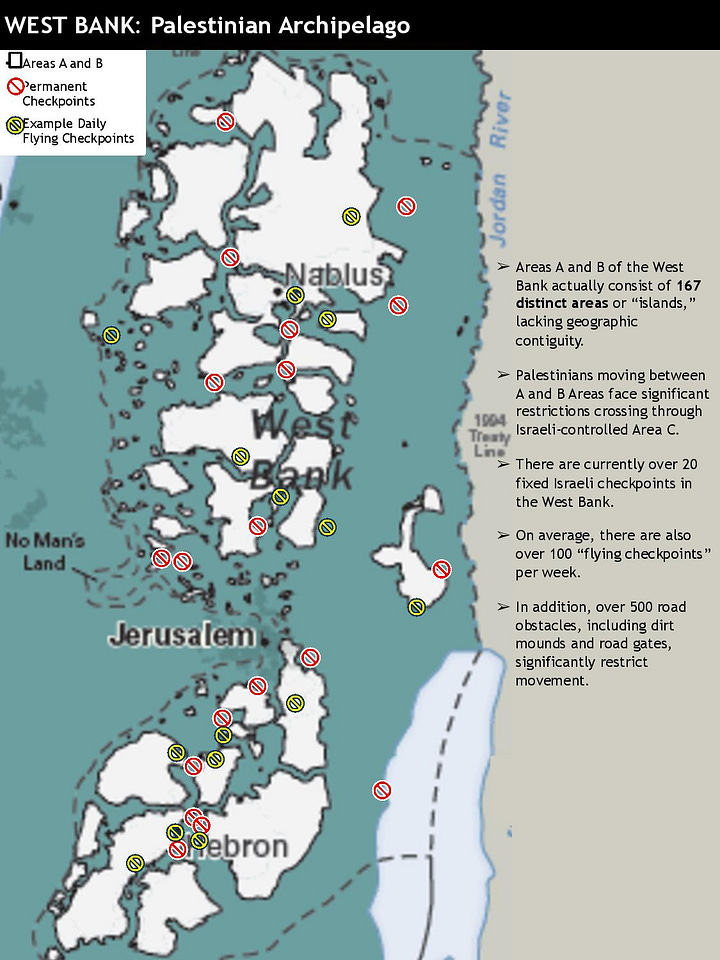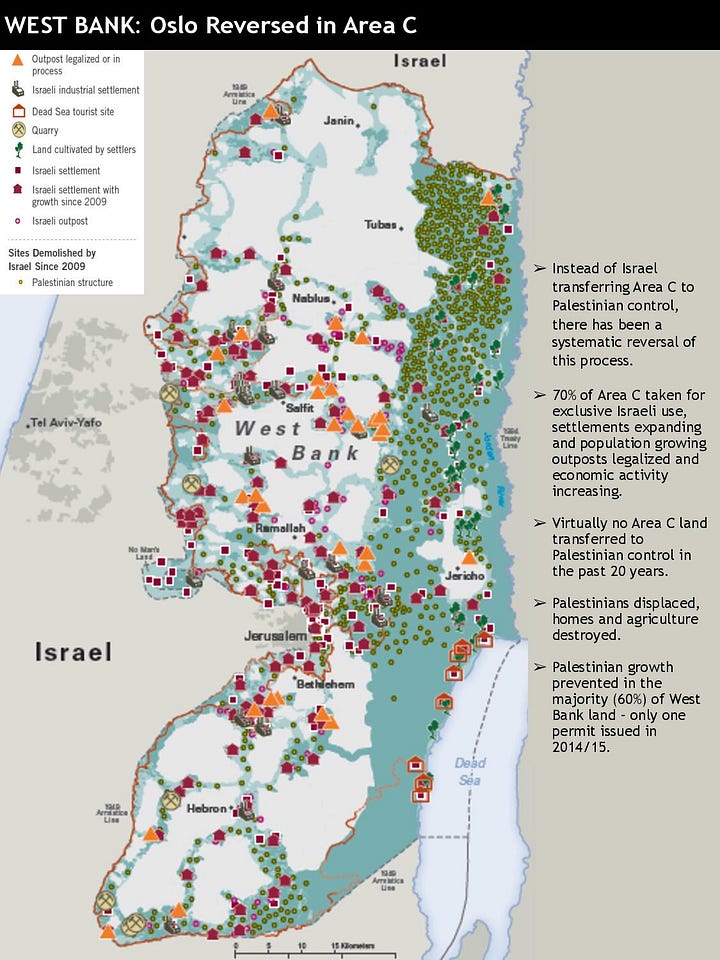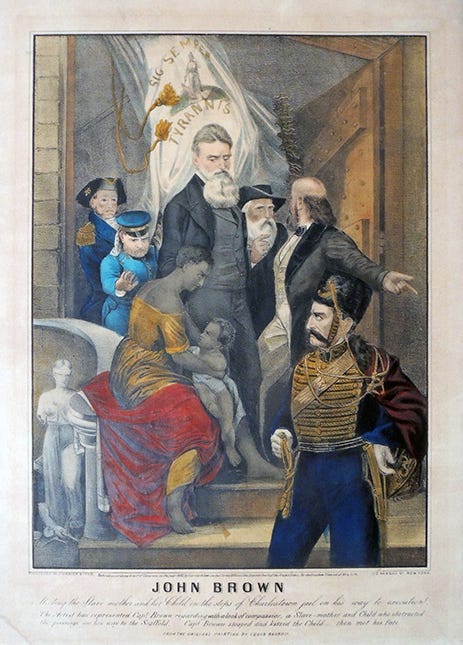A Plea for Genuine Peace in Liberation
If we are to take these atrocities seriously and treat Jewish victims, survivors, and their families with dignity, it is imperative that we address the root causes in Israel’s subjugation of Palestine
On May 30, 1881, Frederick Douglass gave a speech in Harpers Ferry, West Virginia about his longtime friend and fellow-abolitionist John Brown. “Did John Brown draw his sword against slavery,” he asked, “and thereby lose his life in vain?” Twenty-two years after Brown was executed for trying to spark an abolitionist rebellion of enslaved people in northern Virginia, Douglass replied “to this I answer ten thousand times, No! No man fails, or can fail, who so grandly gives himself and all he has to a righteous cause.”
I think a lot about the Harpers Ferry raid and militant abolitionism more broadly because no single event had a greater impact in bringing about the destruction of slavery in the U.S. “John Brown,” Douglass reminded listeners, “began the war that ended American slavery and made this a free Republic.” Prior to Brown’s raid into slave country, “the prospect for freedom was dim, shadowy and uncertain.” Without citizenship, voting rights, and in the words of the Dredd Scott ruling, having “no rights which the white man was bound to respect,” Black Americans had no meaningful ability to achieve emancipation legally, a fact enslavers had woven into the Constitution itself. “The irrepressible conflict,” Douglass observed, “was one of words, votes and compromises” between elite white men with no formal opportunity for input from or collaboration with Black Americans. John Brown’s raid changed all that.

While many of us rightly celebrate Brown’s desire to strike a deathblow to slavery as righteous, it is crucial that we recognize that he was also a religious fanatic and terrorist. He helped fund, train, and equip abolitionist militants in their unofficial war against enslavers in Kansas and attempted to spark a much larger conflict on the scale of the Haitian Revolution. The Haitian Revolution had become a topic of fascination and celebration of American abolitionists, who modeled their militant abolition after one of its leaders, Toussaint Louverture. Brown’s plan at Harpers Ferry had been inspired in part by the success of the revolutionary slave revolt in Haiti, which destroyed slavery on the island and created the first state to abolish slavery in the Western Hemisphere. Taken with the example of Haiti, abolitionists across the northern and western U.S. viewed an eventual slave revolt as likely due to the dehumanizing conditions under which enslaved people lived. Such a violent and oppressive regime, they reasoned, could only inspire its own ultimate destruction in revolutionary violence.

As I consider the horror unfolding in Israel right now—a horror that now promotes further mass suffering and dispossession—I cannot look away from the legacy of Brown. What might he have said about the terrible actions of desperate and stateless people crammed into decades-old refugee camps without freedom of movement, self determination, and access to basic opportunities? A people literally fenced in and now deprived of electricity, food, and water.
I am not asking you to look away from or excuse atrocities, either in the present or the past. I believe that it is our responsibility to refuse to do so. But what that requires in actuality is an acknowledgement of the existing apartheid regime in Israel that leaves residents of Gaza under Israeli occupation and without legal recourse. That doesn’t make the Hamas attack or the massive preceding Israeli state and settler violence “justified”—no such thing exists. What I do hope, however, is that we look carefully and thoughtfully at what Haaretz identified as “the dangers [Netanyahu] was consciously leading Israel into when establishing a government of annexation and dispossession.” I believe that we owe that to the victims of the Hamas attack and of the state and retributive violence meted out against a stateless people.
While there is room for an objection to the violent methods Hamas employed, that objection would fail to justify the plunder and violence of the Israeli occupation that preceded it. Since 2008, the Israeli military has killed more than six thousand Palestinians and injured more than 150,000, a casualty rate twenty-four times that suffered by Israel during that same span. The reason for these disparate casualty rates is not merely technological—better equipment and weapons funded in part by 3.8 billion dollars in annual military aid from the U.S.—but a matter of policy. Israel has for years now pursued a policy of “mowing the grass”—periodic killings and arrests of protestors and militants in Gaza. Moreover, the heavy restrictions imposed by Israel since 2007 on movement, food, fuel, and other necessities have turned Gaza into what human rights advocates termed the world’s largest “open air prison.” Such circumstances are quite literally unlivable.
We tend to treat Israel and Palestine as separate countries in our media coverage in the U.S., but again, this simply isn’t the case. Not only has Israel occupied Gaza and the West Bank—the two separate regions that make up Palestine—for the past 55 years, but it has also pursued a policy of subdivision and restriction within those territories. Severe restrictions on where Palestinians can live, combined with Israeli military checkpoints throughout the West Bank and Gaza, create “167 distinct areas or ‘islands,’ lacking geographic contiguity” according to a U.S. State Department briefing. This is not a state in any meaningful sense. Its people lack basic rights of self-determination and governance and in fact live under Israeli military law as opposed to the civilian courts enjoyed by Israeli settlers in Palestinian areas. Residents of the West Bank have regularly faced the demolition of their homes and towns and the theft of their land by those settlers. It is, in every respect, an apartheid regime.


As in other liberation movements, Palestinian counter-violence has long existed alongside the criminalization of peaceful protests. Israel has regularly shot unarmed Palestinian protestors, shooting as many as 6000 with sniper fire during the 2018 March of Return demonstration in Gaza. But this is not merely a de facto criminalization we’ve become familiar with in the U.S., where police use escalation tactics before attacking unarmed protestors. Under Military Order 1651, Israel criminalized “orally or in another way, to influence public opinion in the region in a manner which may harm public peace or public order,” carrying a sentence of ten years imprisonment for those found in violation. Even carrying the coffin of journalist Shireen Abu Akleh, slain by Israeli soldiers in 2022, subjects Palestinian mourners and observers to severe beatings by Israeli police. Israeli military rule forces those wanting to promote change and seek self-determination to undergo enormous personal risk while offering no legal avenues or recourse for their grievances. It creates a perfect recipe for instability, suffering, and violence.
Again, I don’t say any of this to be glib about the absolute horror unfolding in Israel. It is a tragedy and one that we should all mourn. If we are to take these atrocities seriously, however, and if we are to treat those victims, survivors, and their families with dignity, it is imperative that we address their root causes in colonial subjugation with the gravity that those crimes deserve.
Colonial and apartheid regimes breed instability. They create unnecessary suffering both for targeted and subjugated populations and also for those recognized by the state as full citizens. So when we say that such regimes are dangerous, we don’t mean simply in a moral sense, but also in an existential one. Reactionary regimes create the very conditions of instability and unrest that they claim to address. They make the world a more dangerous place and should be opposed at every opportunity. Or as Ofer Cassif, a leftist member of Israel’s governing Knesset, put it, “innocent people, innocent civilians on both sides, Israelis and Palestinians, pay the price of the arrogant, criminal, ongoing occupation that Israel refuses to end.”
When John Brown faced a jury for his crimes against slave country in 1859, he did so unapologetically. “I believe that to have interfered as I have done,” Brown told the Court, “as I have always freely admitted I have done, in behalf of [the] despised poor, I have done no wrong, but RIGHT.” Perhaps that pronouncement was a step too far. Violence of any kind is always an abomination. However, what Brown and Douglass knew all too well was that they supported and deployed violence because it offered a defense against the already-existing enslaver regime of violence and oppression. They understood that failure to act meant the continuation of a massive system of rape, murder, theft, and oppression operated by enslavers to enrich and empower themselves at the expense of Black Americans.
Again, I don’t mean to suggest that their use of violence was either justified or unjustified; I don’t believe any such distinction exists. Instead, I make sense of their violence as an expression of the enslaver regime against which they struggled, an inevitable byproduct of a machine created by the ruling class to turn violence into profit and power.
People will do what they must to survive and live with dignity when possible, putting them into inevitable conflict with those operating colonial regimes. That search for dignity led Douglass to attack his enslaver, to escape enslavement, and to work vigorously to overthrow slavery. In his famous “power concedes nothing without a demand” speech, Douglass argued that the only language enslavers respected was violence, concluding that “Negroes will be hunted at the North and held and flogged at the South so long as they submit to those devilish outrages and make no resistance.” For Douglass, the historical evidence was clear:
I am aware that the insurrectionary movements of the slaves were held by many to be prejudicial to their cause. This is said now of such movements at the South. The answer is that abolition followed close on the heels of insurrection in the West Indies, and Virginia was never nearer emancipation than when General [Nat] Turner kindled the fires of insurrection at Southampton.
Douglass understood insurrectionary violence as working in tandem with negotiation and legislation to overthrow an existing and totalizing system of violence in slavery. “Who would be free,” Douglass thundered, “themselves must strike the blow.”

Acting on precisely that logic, Brown recruited twenty-one abolitionists, sixteen white and five Black, and approached Harpers Ferry on the night of October 16, 1859, hoping to capture the federal armory there and obtain enough weapons and support from enslaved people to spark a massive revolt. Brown’s moment had come, but no support came from the enslaved men, women, and children of Harpers Ferry. Overpowered by enslavers and future-Confederates Robert Lee and J.E.B. Stuart, Brown was captured and convicted of treason. Following Douglass’ call to insurrectionary violence, Brown announced that “if it is deemed necessary that I should forfeit my life, for the furtherance of the ends of justice, and MINGLE MY BLOOD FURTHER WITH THE BLOOD OF MY CHILDREN, and with the blood of millions in this Slave country, whose rights are disregarded by wicked, cruel, and unjust enactments, – I say; LET IT BE DONE.”
As we approach the anniversary of Brown’s raid on Harpers Ferry, I want to consider whether we might be seeing a similarly tragic and terrible movement against repression, plunder, and state violence at work in Israel, one that has resulted in the deaths of civilians in precisely the way that Brown’s insurrection attempted. If there is a lesson in all of this, perhaps it is this: that systems of oppression create the terrible conditions of rebellion. That when those in power choose domination, they likewise choose death and destruction. That achieving peace requires nothing short of an embrace of justice and liberation. May we hasten its arrival.


